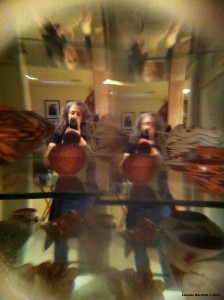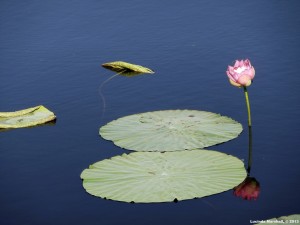Over the years I have had something of a love/hate relationship with reflections. When I was young, I always wanted, just once, for the person I saw reflected in the mirror to be a movie star, and not the awkward girl that I perceived myself to be. As I grew older, I began to understand that our expectations of what we wanted to see in the mirror were based on the deliberate marketing of false expectations that fed our insecurities. I also began to realize that much of what women were expected to look like was informed by the male gaze. Wall upon wall in museums were (and still are) filled with images of how men see women and television and the movies are, even today, dominated by male perceptions of what women should look like.
Some years ago, those realizations led to my doing a series of artistic explorations about how women see themselves including several pieces on mirror glass that are impossible to view without one’s own reflection becoming part of what is seen, as mine is in this photo of Venus Deconstructed. By definition, this work looks different to each person as they become reflected in the mirrored surface as they view it.
More recently, I’ve worked with some photographic reflections that by virtue of technique completely change the nature of what is reflected, using duplicating lenses and shooting images in multi-dimensional surfaces (think disco balls). When the subject of the photo is a person, it is usually me because I’m not comfortable asking others to subject themselves to my reflected distortions.
Some of the most breathtaking reflections are of course found in nature, something I was reminded of a few weeks ago when walking at a nearby lake which contains a stunning field of water lotuses. Growing as they do in the water, on a sunny day it is almost as if the field is of double density because you see not only the lotuses but also their reflections. But what is particularly breathtaking is the subtle difference between the flowers and their reflections in the water. To my eye, the image of the flower and its reflection is beautiful and each taken separately is also beautiful. But perhaps if I was the flower, I would hate that my petals look so dark and that the image in the water seems so flat.
So why do I tell you all this? Because much of what we see, whether it is in a mirror, or in an advertisement for the latest shade of lipstick or the idealized images on a museum wall, are distortions of reality, whether due to optical effect or the subjective gaze of the image’s creator. Yet these distortions so often become the reality of what we see that, to borrow from my favorite Lily Tomlin monologue, it becomes quite difficult to explain the difference between a can of soup and an Warhol painting of the same.
I show’em this can of Campbell’s tomato soup.
I say,
“This is soup”.
Then I show’em a picture of Andy Warhol’s painting
of a can of Campbell’s tomato soup. I say,
“This is art.”“This is soup.”
“And this is art.”
Then I shuffle the two behind my back.
Now what is this?
No.
this is soup and this is art!I dread having to explain tartar sauce!
Whatever you may think of the reflected lotus in the photo above, it isn’t the same as the lotus and our reflection in the mirror is not who we are or even what we look like. And airbrushed advertisements are not what the models we think we are seeing look like and the people in a Picasso painting most definitely aren’t the distortions that he painted. Maybe that is obvious, but I know that I spend way too much time in front of mirrors trying to make myself look a little better than I think I look and perhaps it is useful to reflect on the fact that we aren’t our reflections, nor are we how others view us.



